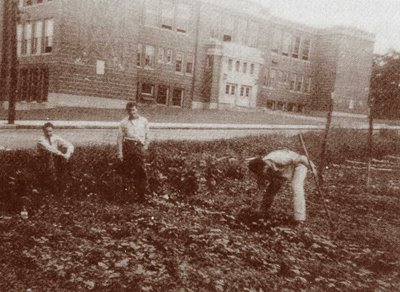Robbins Farm Park was once a working farm
Arlington bought the land for this park in 1942, almost 70 years ago, from a farmer named Nathan Robbins. The farm had been in Robbins' family for over 200 years. It was purchased originally in 1734, back when Massachusetts was still a British colony.
Nathan Robbins loved farming. He worked this farm, usually with just one helper, until he was 74.
The farm had one cow, Helen, a workhorse named Tommy, and a chicken house whose eggs Farmer Robbins delivered every other day around town. The farm had an apple and pear orchard, hayfields, and several fields of corn. In one of those, beets and beans were also often grown in rotation.
The farm also had a separate vegetable garden, up in its northernmost corner, back behind a prominent ledge of rock. There Mr. Robbins grew carrots, onions, asparagus, and rhubarb.
The two maps below show what the Robbins farm looked like back then, compared to what the park looks like now.

At the time the Town purchased this land from Farmer Robbins, the United States had just entered World War II. President Roosevelt had urged communities and individual households to help save money and scarce resources in support of the war effort by growing vegetables at home for their own use, so that a larger share of commercially grown produce could be sent to our fighting forces overseas.

These homegrown gardens were called Victory Gardens. Eleanor Roosevelt planted a Victory Garden of her own at the White House.
Arlington joined the Victory Garden effort in a big way. In 1943, the recently acquired Robbins Farm became home to 66 gardens. It continued in that use until the close of the war.
Lots of good food came out of those gardens. At the end of program's first year, park commissioners reported that 234 different people had participated in some way in planting, hoeing, weeding and harvesting the gardens' vegetables. Together these gardeners had produced "1,100 bushels of vegetables, 600 pounds of pumpkin and winter squash, and small quantities of other unusual vegetables."

From that output, the commissioners said, 9,108 pints of food had been canned. They also estimated the program's net financial benefit to the community. Expressed in today's dollars, they placed the market value of the gardens' output at roughly $41,300, against which the gardeners' out-of-pocket costs came to just over $7,300. That meant a savings of $34,000 overall, a little more than $500 per garden. Those calculations did not include, of course, the cost of the labor those 234 people had put into their gardens.
A 1943 article in the Arlington Advocate, however, hints that many of the Robbins Farm gardeners did not look on their garden efforts as just so much wage labor. Late that September, a bunch of the gardeners staged a "field day" where, among other activities, they set up exhibits of their fresh and canned produce. Lots of people came to look. 1st, 2nd, and 3rd place ribbons were awarded to the top exhibitors. Among the viewers was none other than Mr. Nathan Robbins, "a favorite of the children," the article noted, "of several generations, in fact."
~ :: ~
You can read lots more about Mr. Robbins and his farm, including interviews with people who knew him well, in Oakes Plimpton's book, Robbins Farm Park, A Local History — From the Revolutionary War to the Present, 3rd Edition 2007, Friends of Robbins Farm Park.


